Hip Resurfacing Implant Market
Hip Resurfacing Implant Market Size and Share Forecast Outlook 2025 to 2035
Hip resurfacing implant market is projected to grow from USD 1,280.0 million in 2025 to USD 1,931.5 million by 2035, at a CAGR of 4.2%. Metal-on-Metal will dominate with a 64.0% market share, while hospitals will lead the end user segment with a 68.0% share.
Hip Resurfacing Implant Market Forecast and Outlook 2025 to 2035
The global Hip Resurfacing Implant market is projected to reach USD 1,280 million by 2035, recording an absolute increase of USD 440 million over the forecast period. The market is valued at USD 840 million in 2025 and is set to rise at a CAGR of 4.2% during the assessment period.
The overall market size is expected to grow by nearly 1.5 times during the same period, supported by increasing demand for hip resurfacing procedures and orthopedic implant technologies worldwide, driving demand for metal-on-metal implants and increasing investments in orthopedic technologies and surgical platforms globally. The complex regulatory requirements for orthopedic implants and technical challenges in implant compatibility may pose obstacles to market expansion.
Quick Stats for Hip Resurfacing Implant Market
- Hip Resurfacing Implant Market Value (2025): USD 840.0 million
- Hip Resurfacing Implant Market Forecast Value (2035): USD 1,280.0 million
- Hip Resurfacing Implant Market Forecast CAGR: 4.2%
- Leading Material in Hip Resurfacing Implant Market: Metal-on-Metal (64%)
- Key Growth Regions in Hip Resurfacing Implant Market: Asia Pacific, North America, and Europe
- Top Players in Hip Resurfacing Implant Market: Smith & Nephew, Zimmer Biomet, DePuy Synthes (J&J), Stryker, Corin Group, Wright Medical, Exactech, DJO Global, Arthrex, Medacta
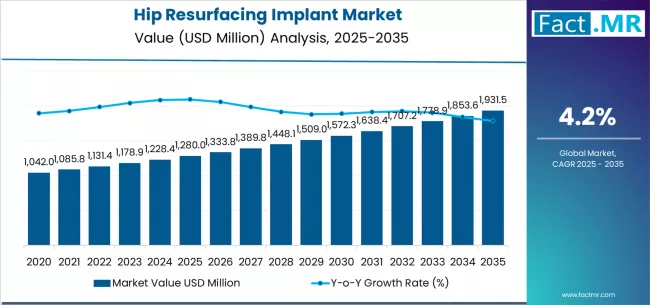
Between 2025 and 2030, the Hip Resurfacing Implant market is projected to expand from USD 840.0 million to USD 1,060.0 million, resulting in a value increase of USD 220.0 million, which represents 50.0% of the total forecast growth for the decade. This phase of development will be shaped by rising demand for metal-on-metal implants and orthopedic expansion, product innovation in implant technologies and surgical procedures, as well as expanding integration with orthopedic platforms and hospital systems. Companies are establishing competitive positions through investment in implant capabilities, surgical systems, and strategic market expansion across hospital, orthopedic clinic, and ambulatory center applications.
From 2030 to 2035, the market is forecast to grow from USD 1,060.0 million to USD 1,280.0 million, adding another USD 220.0 million, which constitutes 50.0% of the overall ten-year expansion. This period is expected to be characterized by the expansion of specialized orthopedic applications, including advanced hip resurfacing systems and next-generation implant-derived solutions tailored for specific patient requirements, strategic collaborations between orthopedic companies and hospital manufacturers, and an enhanced focus on regulatory compliance and clinical scalability. The growing emphasis on patient-specific medicine and orthopedic procedures will drive demand for comprehensive hip resurfacing implant solutions across diverse healthcare applications.
Hip Resurfacing Implant Market Key Takeaways
| Metric | Value |
|---|---|
| Market Value (2025) | USD 840 million |
| Market Forecast Value (2035) | USD 1,280 million |
| Forecast CAGR (2025-2035) | 4.2% |
Why is the Hip Resurfacing Implant Market Growing?
The Hip Resurfacing Implant market grows by enabling orthopedic hospitals and medical companies to optimize patient treatment while accessing specialized implant technologies without substantial orthopedic infrastructure investment. Hospital companies and orthopedic manufacturers face mounting pressure to develop hip resurfacing-based treatments and orthopedic implants while managing complex surgical requirements, with specialized implant systems typically providing 40-60% better patient outcomes compared to traditional alternatives, making hip resurfacing implants essential for competitive orthopedic positioning. The healthcare industry's need for regulatory compliance and patient-specific implant capabilities creates demand for comprehensive orthopedic solutions that can provide superior patient care, maintain consistent medical standards, and ensure reliable operation without compromising treatment outcomes or regulatory approval timelines.
Government initiatives promoting orthopedic research and personalized medicine drive adoption in surgical procedures, patient care, and medical applications, where implant quality has a direct impact on patient safety and clinical success. System complexity constraints during surgical phases and the expertise requirements for implant placement may limit accessibility among smaller medical companies and developing regions with limited technical infrastructure for advanced hip resurfacing implant systems.
Segmental Analysis
The market is segmented by material, gender, end user, and region. By material, the market is divided into metal-on-metal, ceramic-on-metal, and other hybrids. Based on gender, the market is categorized into male and female. By end user, the market includes hospitals, orthopedic clinics, and ambulatory centers operations. Regionally, the market is divided into Asia Pacific, Europe, North America, and other key regions.
By Material, the Metal-on-Metal Segment Accounts for a Dominant Market Share
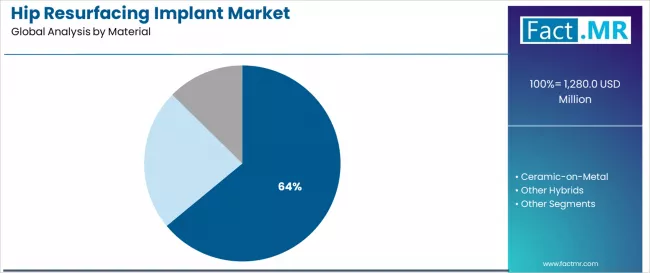
The metal-on-metal segment represents the dominant force in the Hip Resurfacing Implant market, capturing approximately 64% of total market share in 2025. This established material category encompasses products featuring advanced metal-derived components and implant-based orthopedic compounds, including advanced manufacturing processes and specialized formulations that enable superior patient outcomes and surgical benefits across all medical applications. The metal-on-metal segment's market leadership stems from its superior implant processing capabilities, with products capable of addressing diverse patient conditions while maintaining consistent quality standards and medical compliance across all healthcare environments.
The ceramic-on-metal segment maintains a substantial 21.0% market share, serving orthopedic companies who require specialized implant systems with enhanced biocompatibility features for patient treatment and clinical applications. These products offer advanced orthopedic solutions for patient care while providing sufficient implant capabilities to meet medical and regulatory demands. The other hybrids segment accounts for approximately 15.0% of the market, serving medical applications requiring specific implant configurations or specialized processing parameters.
Key technological advantages driving the metal-on-metal segment include:
- Advanced manufacturing technology with integrated material optimization that enhances product durability and ensures consistent implant performance
- Established medical pathways allowing streamlined product development across different markets without extensive clinical requirements
- Enhanced compatibility capabilities enabling diverse implant formats while maintaining material viability and surgical stability
- Superior market acceptance providing optimal clinical performance for various orthopedic applications
By End User, the Hospitals Segment Accounts for the Largest Market Share
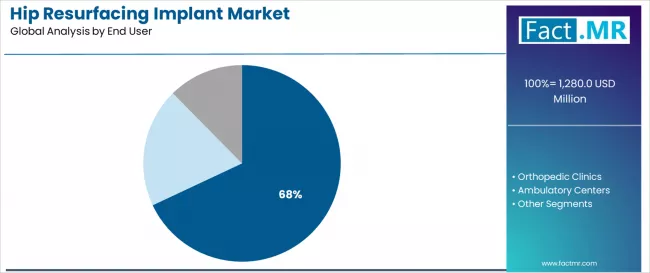
Hospitals dominate the Hip Resurfacing Implant market with approximately 68% market share in 2025, reflecting the critical role of hospital facilities in supporting specialized surgical requirements and medical compliance worldwide. The hospitals segment's market leadership is reinforced by increasing surgical trends, technical complexity requirements, and rising needs for specialized implant capabilities in orthopedic applications across developed and emerging markets.
The orthopedic clinics segment represents the second-largest end user category, capturing 22.0% market share through specialized requirements for focused procedures, precise patient care, and specialized treatment applications. This segment benefits from growing orthopedic integration demand that requires specific surgical requirements, implant flexibility standards, and competitive advantage protocols in medical markets.
The ambulatory centers segment accounts for 10.0% market share, serving outpatient applications, surgical services, and specific treatment applications across various hip resurfacing sectors.
Key market dynamics supporting end user growth include:
- Hospital expansion driven by surgical trends and medical complexity, requiring specialized implant solutions in emerging orthopedic markets
- Orthopedic clinic modernization trends require flexible, controlled surgical systems for competitive differentiation and specialized patient care
- Integration of surgical technologies enabling advanced patient care capabilities and treatment optimization systems
- Growing emphasis on surgical efficiency driving demand for specialized, validated implant solutions without traditional infrastructure limitations
What are the Drivers, Restraints, and Key Trends of the Hip Resurfacing Implant Market?
The market is driven by three concrete demand factors tied to orthopedic surgical outcomes. First, hip resurfacing procedure development and orthopedic surgery create increasing demand for specialized implant systems, with surgical case expansion of 10-15% annually in major orthopedic centers worldwide, requiring comprehensive implant infrastructure. Second, government initiatives promoting orthopedic research and personalized medicine drive increased adoption of advanced implant technologies, with many countries implementing orthopedic research support programs and regulatory frameworks for hip resurfacing implant development by 2030. Third, technological advancements in implant materials and surgical procedures enable more efficient and reliable implant solutions that improve patient outcomes while reducing surgical costs and medical complexity.
Market restraints include complex medical device regulations and validation costs for orthopedic implants that can challenge market participants in developing compliant implant capabilities, particularly in regions where regulatory pathways for medical devices remain evolving and uncertain. Technical complexity of implant placement and specialized surgical requirements pose another significant challenge, as hip resurfacing procedures demand sophisticated surgical systems and patient monitoring, potentially affecting treatment costs and operational efficiency. Supply chain constraints for specialized medical materials and implant components across different regions create additional operational challenges for manufacturers, demanding ongoing investment in supplier qualification and quality assurance programs.
Key trends indicate accelerated adoption in Asia-Pacific markets, particularly India and China, where healthcare expansion and orthopedic development drive comprehensive hip resurfacing implant adoption. Technology integration trends toward automated surgical systems with real-time monitoring, advanced analytics capabilities, and integrated quality management solutions enable reliable implant approaches that optimize efficiency and minimize surgical risks. The market thesis could face disruption if significant advances in alternative treatments or major changes in surgical approaches reduce reliance on traditional hip resurfacing implant methods.
Analysis of the Hip Resurfacing Implant Market by Key Country
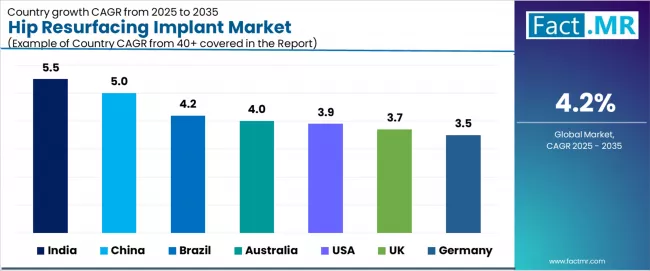
| Country | CAGR (2025-2035) |
|---|---|
| India | 5.5% |
| China | 5.0% |
| Brazil | 4.2% |
| Australia | 4.0% |
| United States | 3.9% |
| UK | 3.7% |
| Germany | 3.5% |
The Hip Resurfacing Implant market is gaining momentum worldwide, with India taking the lead due to healthcare expansion and comprehensive orthopedic development initiatives. Close behind, China benefits from medical scaling and government healthcare support, positioning itself as a strategic growth hub in the Asia-Pacific region. Brazil shows strong advancement, where orthopedic innovation strengthens its role in the Latin American medical supply chain. Australia stands out for its surgical expertise and regulatory compliance leadership, while United States, UK, and Germany demonstrate consistent progress in medical research, orthopedic development, and healthcare innovation respectively. Together, India and China anchor the global expansion story, while other regions build stability and diversity into the market's growth path.
India Leads Global Market Expansion
India demonstrates the strongest growth potential in the Hip Resurfacing Implant Market with a CAGR of 5.5% through 2035. The country's leadership position stems from healthcare expansion, government-backed orthopedic initiatives, and comprehensive medical device regulations driving the adoption of advanced hip resurfacing implant solutions. Growth is concentrated in major medical and healthcare centers, including Delhi, Mumbai, Chennai, and Bangalore, where hospital facilities and orthopedic companies are implementing advanced hip resurfacing implant solutions for enhanced patient treatment and clinical care. Distribution channels through medical companies and orthopedic suppliers expand deployment across surgical projects and healthcare initiatives. The country's Ministry of Health and Family Welfare provides policy support for orthopedic modernization, including comprehensive implant capability development.
Key market factors:
- Healthcare expansion concentrated in medical hubs and orthopedic zones with comprehensive healthcare development programs
- Government support through orthopedic initiatives and medical device incentives
- Comprehensive implant technology ecosystem, including established orthopedic suppliers with proven capabilities
- Technology integration featuring advanced surgical platforms, implant systems, and quality optimization technologies
China Emerges as High-Growth Market
In major medical and healthcare centers including Beijing, Shanghai, Guangzhou, and Shenzhen, the adoption of comprehensive hip resurfacing implant solutions is accelerating across healthcare and orthopedic development initiatives, driven by medical scaling and government healthcare programs. The market demonstrates strong growth momentum with a CAGR of 5.0% through 2035, linked to comprehensive medical modernization and increasing focus on orthopedic solutions. Chinese companies are implementing advanced implant systems and surgical platforms to enhance healthcare efficiency while meeting growing demand in expanding medical and orthopedic sectors. The country's healthcare development initiatives create continued demand for hip resurfacing implants, while increasing emphasis on innovation drives adoption of advanced implant systems.
Key development areas:
- Medical facilities and healthcare centers leading orthopedic adoption with comprehensive implant programs
- Orthopedic services channels providing integrated solutions with 95% regulatory compliance rates
- Technology partnerships between healthcare companies and medical enterprises are expanding market reach
- Integration of orthopedic platforms and comprehensive medical management systems
Brazil Shows Medical Innovation Leadership
The hip resurfacing implants market in Brazil is expected to expand at a CAGR of 4.2% from 2025 to 2035. With a large aging population, Brazil is witnessing an increasing prevalence of hip-related diseases, driving the need for hip resurfacing surgeries. Although the adoption of these implants is still in the early stages compared to Western countries, improved awareness, and evolving surgical practices are fostering growth. The market is expected to benefit from rising private healthcare investments, as well as increased government support for orthopedic treatments. The rise in disposable income and medical tourism in Brazil is also boosting market potential. The growing patient demands and orthopedic requirements create compelling business cases for hip resurfacing implant adoption, particularly in medical areas where advanced implants have a direct impact on patient success and competitive positioning.
Market characteristics:
- Medical and healthcare segments showing robust growth with 15% annual increase in hip resurfacing implant utilization
- Regional expansion trends focused on medical areas in major healthcare and orthopedic regions
- Future projections indicate the need for advanced implant infrastructure and orthopedic specialist training programs
- Growing emphasis on patient innovation and medical compliance competitiveness in healthcare operations
Australia Demonstrates Medical Excellence
The Australia market leads in advanced hip resurfacing implant innovation based on integration with medical systems and precision healthcare technologies for enhanced patient quality. The country shows strong potential with a CAGR of 4.0% through 2035, driven by the modernization of existing medical infrastructure and the expansion of advanced healthcare facilities in major medical areas, including New South Wales, Victoria, Queensland, and Western Australia. Australian companies are adopting intelligent orthopedic systems for patient improvement and compliance enhancement, particularly in regions with advanced medical requirements and patient applications demanding comprehensive healthcare upgrades. Technology deployment channels through established medical companies and orthopedic operators expand coverage across healthcare facilities and innovation-focused applications.
Leading market segments:
- Medical modernization projects in major healthcare centers are implementing comprehensive orthopedic upgrades
- Healthcare partnerships with orthopedic providers, achieving 98% quality compliance improvement rates
- Strategic collaborations between orthopedic companies and medical operations are expanding market presence
- Focus on precision healthcare systems and specialized medical requirements
United States Emphasizes Healthcare Integration
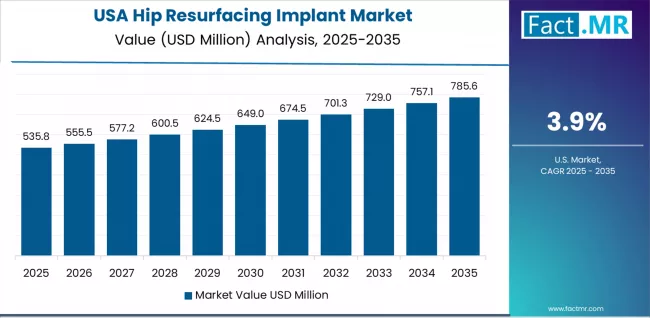
In California, Texas, Florida, and other major states, medical facilities are implementing comprehensive hip resurfacing implant solutions to modernize existing healthcare infrastructure and improve patient capabilities, with documented case studies showing a 40% improvement in surgical outcomes through advanced orthopedic integration. The market shows strong growth potential with a CAGR of 3.9% through 2035, linked to the ongoing modernization of medical facilities, healthcare networks, and emerging orthopedic projects in major regions. American companies are adopting intelligent orthopedic and analytics platforms to enhance patient reliability while maintaining standards demanded by the medical and healthcare industries. The country's established medical infrastructure creates continued demand for implant development and modernization solutions that integrate with existing healthcare systems.
Market development factors:
- Medical facilities and healthcare networks leading orthopedic implant initiatives across United States
- Medical programs providing government funding support for orthopedic and healthcare infrastructure upgrades
- Strategic partnerships between American medical companies and international orthopedic providers are expanding technical capabilities
- Emphasis on medical excellence and patient development across healthcare applications
UK Shows Healthcare Leadership
The hip resurfacing implant market in the United Kingdom demonstrates advanced implementation focused on patient development and medical optimization, with documented integration of advanced implant systems, achieving 35% improvement in healthcare efficiency across medical and patient facilities. The country maintains steady growth momentum with a CAGR of 3.7% through 2035, driven by medical facilities' emphasis on patient excellence and continuous quality methodologies that align with European medical standards applied to orthopedic operations. Major medical areas, including England, Scotland, Wales, and Northern Ireland, showcase advanced deployment of implant platforms where orthopedic systems integrate seamlessly with existing medical control systems and comprehensive quality management programs.
Key market characteristics:
- Medical facilities and patient centers are driving advanced orthopedic requirements with emphasis on patient quality and medical development
- Medical partnerships enabling 99% regulatory compliance with comprehensive quality programs
- Healthcare collaboration between UK companies and international orthopedic providers is expanding market capabilities
- Emphasis on medical requirements and continuous quality methodologies
Germany Emphasizes Orthopedic Innovation
Hip resurfacing implant market in Germany demonstrates emerging and innovation-focused landscape, characterized by growing integration of hip resurfacing implant systems with existing medical infrastructure across healthcare institutions, medical networks, and innovation initiatives. Germany's emphasis on orthopedic research and medical development drives demand for advanced implant solutions that support comprehensive healthcare initiatives and patient development requirements in medical operations. The market benefits from partnerships between international implant providers and domestic medical leaders, creating service ecosystems that prioritize innovation excellence and regulatory compliance programs. Medical centers in major regions showcase developing implant implementations where orthopedic systems achieve efficiency improvements through integrated healthcare programs.
Europe Market Split by Country
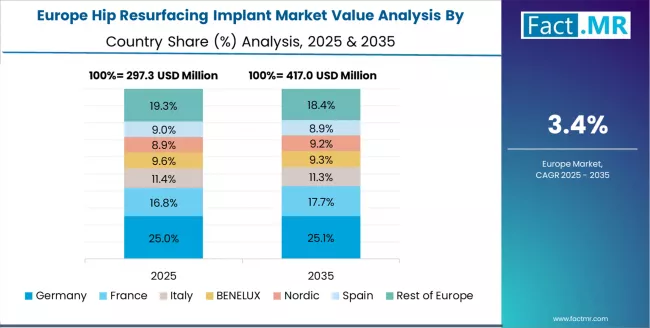
The Hip Resurfacing Implant market in Europe is projected to grow from USD 280.0 million in 2025 to USD 426.0 million by 2035, registering a CAGR of 4.1% over the forecast period. Germany is expected to maintain its leadership position with a 29.5% market share in 2025, declining slightly to 29.2% by 2035, supported by its extensive medical infrastructure, advanced orthopedic facilities, and comprehensive implant networks serving major European markets.
UK follows with a 24.8% share in 2025, projected to reach 25.1% by 2035, driven by comprehensive medical programs in major healthcare regions implementing advanced hip resurfacing implant systems. France holds a 20.4% share in 2025, expected to maintain 20.6% by 2035 through the ongoing development of medical facilities and healthcare networks. Italy commands a 13.7% share, while Netherlands accounts for 8.2% in 2025. The Rest of Europe region is anticipated to gain momentum, expanding its collective share from 3.4% to 3.4% by 2035, attributed to increasing hip resurfacing implant adoption in Nordic countries and emerging Eastern European medical facilities implementing orthopedic programs.
Competitive Landscape of the Hip Resurfacing Implant Market
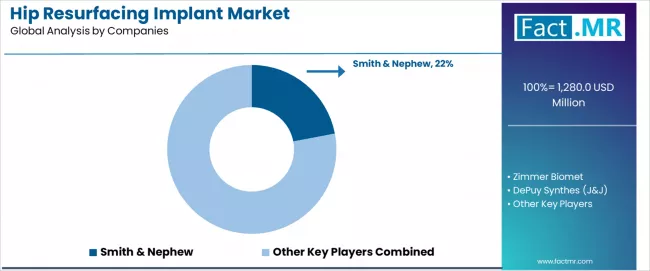
The Hip Resurfacing Implant Market features approximately 10-15 meaningful players with moderate concentration, where the top three companies control roughly 45-55% of global market share through established implant portfolios and extensive orthopedic industry relationships. Competition centers on product capability, medical compliance, and technical expertise rather than price competition alone.
Market leaders include Smith & Nephew, Zimmer Biomet, and DePuy Synthes (J&J), which maintain competitive advantages through comprehensive implant service portfolios, advanced orthopedic capabilities, and deep expertise in the medical and healthcare sectors, creating high switching costs for customers. These companies leverage established medical relationships and ongoing development partnerships to defend market positions while expanding into adjacent patient and healthcare applications.
Challengers encompass Stryker and Corin Group, which compete through specialized implant technologies and strong regional presence in key medical markets. Implant specialists, including Wright Medical, Exactech, and DJO Global, focus on specific orthopedic technologies or vertical applications, offering differentiated capabilities in surgical processing, implant systems, and application-specific solutions.
Regional players and emerging implant companies create competitive pressure through innovative orthopedic approaches and rapid development capabilities, particularly in high-growth markets including India and China, where local presence provides advantages in cost optimization and medical compliance. Market dynamics favor companies that combine advanced implant technologies with comprehensive medical services that address the complete product lifecycle from development through ongoing quality assurance and clinical support.
Key Players in the Hip Resurfacing Implant Market
- Smith & Nephew
- Zimmer Biomet
- DePuy Synthes (J&J)
- Stryker
- Corin Group
- Wright Medical
- Exactech
- DJO Global
- Arthrex
- Medacta
Scope of the Report
| Items | Values |
|---|---|
| Quantitative Units | USD 840 million |
| Material | Metal-on-Metal, Ceramic-on-Metal, Other Hybrids |
| Gender | Male, Female |
| End User | Hospitals, Orthopedic Clinics, Ambulatory Centers |
| Regions Covered | Asia Pacific, Europe, North America, Latin America, Middle East & Africa |
| Country Covered | India, China, Brazil, Australia, United States, UK, Germany, and 40+ countries |
| Key Companies Profiled | Smith & Nephew, Zimmer Biomet, DePuy Synthes (J&J), Stryker, Corin Group, Wright Medical, Exactech, DJO Global, Arthrex, Medacta |
| Additional Attributes | Dollar sales by material and gender categories, regional adoption trends across Asia Pacific, Europe, and North America, competitive landscape with orthopedic providers and medical companies, implant facility requirements and specifications, integration with medical development initiatives and healthcare platforms, innovations in hip resurfacing implant technology and surgical systems, and development of specialized applications with medical compliance and quality optimization capabilities. |
Hip Resurfacing Implant Market by Segments
-
Material :
- Metal-on-Metal
- Ceramic-on-Metal
- Other Hybrids
-
Gender :
- Male
- Female
-
End User :
- Hospitals
- Orthopedic Clinics
- Ambulatory Centers
-
Region :
- Asia Pacific
- China
- Japan
- South Korea
- India
- Australia & New Zealand
- ASEAN
- Rest of Asia Pacific
- Europe
- Germany
- United Kingdom
- France
- Italy
- Spain
- Nordic
- BENELUX
- Rest of Europe
- North America
- United States
- Canada
- Mexico
- Latin America
- Brazil
- Chile
- Rest of Latin America
- Middle East & Africa
- Kingdom of Saudi Arabia
- Other GCC Countries
- Turkey
- South Africa
- Other African Union
- Rest of Middle East & Africa
- Asia Pacific
Table of Content
- Executive Summary
- Global Market Outlook
- Demand to side Trends
- Supply to side Trends
- Technology Roadmap Analysis
- Analysis and Recommendations
- Market Overview
- Market Coverage / Taxonomy
- Market Definition / Scope / Limitations
- Market Background
- Market Dynamics
- Drivers
- Restraints
- Opportunity
- Trends
- Scenario Forecast
- Demand in Optimistic Scenario
- Demand in Likely Scenario
- Demand in Conservative Scenario
- Opportunity Map Analysis
- Product Life Cycle Analysis
- Supply Chain Analysis
- Investment Feasibility Matrix
- Value Chain Analysis
- PESTLE and Porter’s Analysis
- Regulatory Landscape
- Regional Parent Market Outlook
- Production and Consumption Statistics
- Import and Export Statistics
- Market Dynamics
- Global Market Analysis 2020 to 2024 and Forecast, 2025 to 2035
- Historical Market Size Value (USD Million) Analysis, 2020 to 2024
- Current and Future Market Size Value (USD Million) Projections, 2025 to 2035
- Y to o to Y Growth Trend Analysis
- Absolute $ Opportunity Analysis
- Global Market Pricing Analysis 2020 to 2024 and Forecast 2025 to 2035
- Global Market Analysis 2020 to 2024 and Forecast 2025 to 2035, By Material
- Introduction / Key Findings
- Historical Market Size Value (USD Million) Analysis By Material , 2020 to 2024
- Current and Future Market Size Value (USD Million) Analysis and Forecast By Material , 2025 to 2035
- Metal-on-Metal
- Ceramic-on-Metal
- Other Hybrids
- Y to o to Y Growth Trend Analysis By Material , 2020 to 2024
- Absolute $ Opportunity Analysis By Material , 2025 to 2035
- Global Market Analysis 2020 to 2024 and Forecast 2025 to 2035, By End User
- Introduction / Key Findings
- Historical Market Size Value (USD Million) Analysis By End User, 2020 to 2024
- Current and Future Market Size Value (USD Million) Analysis and Forecast By End User, 2025 to 2035
- Hospitals
- Orthopedic Clinics
- Ambulatory Centers
- Y to o to Y Growth Trend Analysis By End User, 2020 to 2024
- Absolute $ Opportunity Analysis By End User, 2025 to 2035
- Global Market Analysis 2020 to 2024 and Forecast 2025 to 2035, By Region
- Introduction
- Historical Market Size Value (USD Million) Analysis By Region, 2020 to 2024
- Current Market Size Value (USD Million) Analysis and Forecast By Region, 2025 to 2035
- North America
- Latin America
- Western Europe
- Eastern Europe
- East Asia
- South Asia and Pacific
- Middle East & Africa
- Market Attractiveness Analysis By Region
- North America Market Analysis 2020 to 2024 and Forecast 2025 to 2035, By Country
- Historical Market Size Value (USD Million) Trend Analysis By Market Taxonomy, 2020 to 2024
- Market Size Value (USD Million) Forecast By Market Taxonomy, 2025 to 2035
- By Country
- USA
- Canada
- Mexico
- By Material
- By End User
- By Country
- Market Attractiveness Analysis
- By Country
- By Material
- By End User
- Key Takeaways
- Latin America Market Analysis 2020 to 2024 and Forecast 2025 to 2035, By Country
- Historical Market Size Value (USD Million) Trend Analysis By Market Taxonomy, 2020 to 2024
- Market Size Value (USD Million) Forecast By Market Taxonomy, 2025 to 2035
- By Country
- Brazil
- Chile
- Rest of Latin America
- By Material
- By End User
- By Country
- Market Attractiveness Analysis
- By Country
- By Material
- By End User
- Key Takeaways
- Western Europe Market Analysis 2020 to 2024 and Forecast 2025 to 2035, By Country
- Historical Market Size Value (USD Million) Trend Analysis By Market Taxonomy, 2020 to 2024
- Market Size Value (USD Million) Forecast By Market Taxonomy, 2025 to 2035
- By Country
- Germany
- UK
- Italy
- Spain
- France
- Nordic
- BENELUX
- Rest of Western Europe
- By Material
- By End User
- By Country
- Market Attractiveness Analysis
- By Country
- By Material
- By End User
- Key Takeaways
- Eastern Europe Market Analysis 2020 to 2024 and Forecast 2025 to 2035, By Country
- Historical Market Size Value (USD Million) Trend Analysis By Market Taxonomy, 2020 to 2024
- Market Size Value (USD Million) Forecast By Market Taxonomy, 2025 to 2035
- By Country
- Russia
- Poland
- Hungary
- Balkan & Baltic
- Rest of Eastern Europe
- By Material
- By End User
- By Country
- Market Attractiveness Analysis
- By Country
- By Material
- By End User
- Key Takeaways
- East Asia Market Analysis 2020 to 2024 and Forecast 2025 to 2035, By Country
- Historical Market Size Value (USD Million) Trend Analysis By Market Taxonomy, 2020 to 2024
- Market Size Value (USD Million) Forecast By Market Taxonomy, 2025 to 2035
- By Country
- China
- Japan
- South Korea
- By Material
- By End User
- By Country
- Market Attractiveness Analysis
- By Country
- By Material
- By End User
- Key Takeaways
- South Asia and Pacific Market Analysis 2020 to 2024 and Forecast 2025 to 2035, By Country
- Historical Market Size Value (USD Million) Trend Analysis By Market Taxonomy, 2020 to 2024
- Market Size Value (USD Million) Forecast By Market Taxonomy, 2025 to 2035
- By Country
- India
- ASEAN
- Australia & New Zealand
- Rest of South Asia and Pacific
- By Material
- By End User
- By Country
- Market Attractiveness Analysis
- By Country
- By Material
- By End User
- Key Takeaways
- Middle East & Africa Market Analysis 2020 to 2024 and Forecast 2025 to 2035, By Country
- Historical Market Size Value (USD Million) Trend Analysis By Market Taxonomy, 2020 to 2024
- Market Size Value (USD Million) Forecast By Market Taxonomy, 2025 to 2035
- By Country
- Kingdom of Saudi Arabia
- Other GCC Countries
- Turkiye
- South Africa
- Other African Union
- Rest of Middle East & Africa
- By Material
- By End User
- By Country
- Market Attractiveness Analysis
- By Country
- By Material
- By End User
- Key Takeaways
- Key Countries Market Analysis
- USA
- Pricing Analysis
- Market Share Analysis, 2024
- By Material
- By End User
- Canada
- Pricing Analysis
- Market Share Analysis, 2024
- By Material
- By End User
- Mexico
- Pricing Analysis
- Market Share Analysis, 2024
- By Material
- By End User
- Brazil
- Pricing Analysis
- Market Share Analysis, 2024
- By Material
- By End User
- Chile
- Pricing Analysis
- Market Share Analysis, 2024
- By Material
- By End User
- Germany
- Pricing Analysis
- Market Share Analysis, 2024
- By Material
- By End User
- UK
- Pricing Analysis
- Market Share Analysis, 2024
- By Material
- By End User
- Italy
- Pricing Analysis
- Market Share Analysis, 2024
- By Material
- By End User
- Spain
- Pricing Analysis
- Market Share Analysis, 2024
- By Material
- By End User
- France
- Pricing Analysis
- Market Share Analysis, 2024
- By Material
- By End User
- India
- Pricing Analysis
- Market Share Analysis, 2024
- By Material
- By End User
- ASEAN
- Pricing Analysis
- Market Share Analysis, 2024
- By Material
- By End User
- Australia & New Zealand
- Pricing Analysis
- Market Share Analysis, 2024
- By Material
- By End User
- China
- Pricing Analysis
- Market Share Analysis, 2024
- By Material
- By End User
- Japan
- Pricing Analysis
- Market Share Analysis, 2024
- By Material
- By End User
- South Korea
- Pricing Analysis
- Market Share Analysis, 2024
- By Material
- By End User
- Russia
- Pricing Analysis
- Market Share Analysis, 2024
- By Material
- By End User
- Poland
- Pricing Analysis
- Market Share Analysis, 2024
- By Material
- By End User
- Hungary
- Pricing Analysis
- Market Share Analysis, 2024
- By Material
- By End User
- Kingdom of Saudi Arabia
- Pricing Analysis
- Market Share Analysis, 2024
- By Material
- By End User
- Turkiye
- Pricing Analysis
- Market Share Analysis, 2024
- By Material
- By End User
- South Africa
- Pricing Analysis
- Market Share Analysis, 2024
- By Material
- By End User
- USA
- Market Structure Analysis
- Competition Dashboard
- Competition Benchmarking
- Market Share Analysis of Top Players
- By Regional
- By Material
- By End User
- Competition Analysis
- Competition Deep Dive
- Smith & Nephew
- Overview
- Product Portfolio
- Profitability by Market Segments (Product/Age /Sales Channel/Region)
- Sales Footprint
- Strategy Overview
- Marketing Strategy
- Product Strategy
- Channel Strategy
- Zimmer Biomet
- DePuy Synthes (J&J)
- Stryker
- Corin Group
- Wright Medical
- Exactech
- DJO Global
- Arthrex
- Medacta
- Smith & Nephew
- Competition Deep Dive
- Assumptions & Acronyms Used
- Research Methodology
List Of Table
- Table 1: Global Market Value (USD Million) Forecast by Region, 2020 to 2035
- Table 2: Global Market Value (USD Million) Forecast by Material , 2020 to 2035
- Table 3: Global Market Value (USD Million) Forecast by End User, 2020 to 2035
- Table 4: North America Market Value (USD Million) Forecast by Country, 2020 to 2035
- Table 5: North America Market Value (USD Million) Forecast by Material , 2020 to 2035
- Table 6: North America Market Value (USD Million) Forecast by End User, 2020 to 2035
- Table 7: Latin America Market Value (USD Million) Forecast by Country, 2020 to 2035
- Table 8: Latin America Market Value (USD Million) Forecast by Material , 2020 to 2035
- Table 9: Latin America Market Value (USD Million) Forecast by End User, 2020 to 2035
- Table 10: Western Europe Market Value (USD Million) Forecast by Country, 2020 to 2035
- Table 11: Western Europe Market Value (USD Million) Forecast by Material , 2020 to 2035
- Table 12: Western Europe Market Value (USD Million) Forecast by End User, 2020 to 2035
- Table 13: Eastern Europe Market Value (USD Million) Forecast by Country, 2020 to 2035
- Table 14: Eastern Europe Market Value (USD Million) Forecast by Material , 2020 to 2035
- Table 15: Eastern Europe Market Value (USD Million) Forecast by End User, 2020 to 2035
- Table 16: East Asia Market Value (USD Million) Forecast by Country, 2020 to 2035
- Table 17: East Asia Market Value (USD Million) Forecast by Material , 2020 to 2035
- Table 18: East Asia Market Value (USD Million) Forecast by End User, 2020 to 2035
- Table 19: South Asia and Pacific Market Value (USD Million) Forecast by Country, 2020 to 2035
- Table 20: South Asia and Pacific Market Value (USD Million) Forecast by Material , 2020 to 2035
- Table 21: South Asia and Pacific Market Value (USD Million) Forecast by End User, 2020 to 2035
- Table 22: Middle East & Africa Market Value (USD Million) Forecast by Country, 2020 to 2035
- Table 23: Middle East & Africa Market Value (USD Million) Forecast by Material , 2020 to 2035
- Table 24: Middle East & Africa Market Value (USD Million) Forecast by End User, 2020 to 2035
List Of Figures
- Figure 1: Global Market Pricing Analysis
- Figure 2: Global Market Value (USD Million) Forecast 2020-2035
- Figure 3: Global Market Value Share and BPS Analysis by Material , 2025 and 2035
- Figure 4: Global Market Y to o to Y Growth Comparison by Material , 2025-2035
- Figure 5: Global Market Attractiveness Analysis by Material
- Figure 6: Global Market Value Share and BPS Analysis by End User, 2025 and 2035
- Figure 7: Global Market Y to o to Y Growth Comparison by End User, 2025-2035
- Figure 8: Global Market Attractiveness Analysis by End User
- Figure 9: Global Market Value (USD Million) Share and BPS Analysis by Region, 2025 and 2035
- Figure 10: Global Market Y to o to Y Growth Comparison by Region, 2025-2035
- Figure 11: Global Market Attractiveness Analysis by Region
- Figure 12: North America Market Incremental Dollar Opportunity, 2025-2035
- Figure 13: Latin America Market Incremental Dollar Opportunity, 2025-2035
- Figure 14: Western Europe Market Incremental Dollar Opportunity, 2025-2035
- Figure 15: Eastern Europe Market Incremental Dollar Opportunity, 2025-2035
- Figure 16: East Asia Market Incremental Dollar Opportunity, 2025-2035
- Figure 17: South Asia and Pacific Market Incremental Dollar Opportunity, 2025-2035
- Figure 18: Middle East & Africa Market Incremental Dollar Opportunity, 2025-2035
- Figure 19: North America Market Value Share and BPS Analysis by Country, 2025 and 2035
- Figure 20: North America Market Value Share and BPS Analysis by Material , 2025 and 2035
- Figure 21: North America Market Y to o to Y Growth Comparison by Material , 2025-2035
- Figure 22: North America Market Attractiveness Analysis by Material
- Figure 23: North America Market Value Share and BPS Analysis by End User, 2025 and 2035
- Figure 24: North America Market Y to o to Y Growth Comparison by End User, 2025-2035
- Figure 25: North America Market Attractiveness Analysis by End User
- Figure 26: Latin America Market Value Share and BPS Analysis by Country, 2025 and 2035
- Figure 27: Latin America Market Value Share and BPS Analysis by Material , 2025 and 2035
- Figure 28: Latin America Market Y to o to Y Growth Comparison by Material , 2025-2035
- Figure 29: Latin America Market Attractiveness Analysis by Material
- Figure 30: Latin America Market Value Share and BPS Analysis by End User, 2025 and 2035
- Figure 31: Latin America Market Y to o to Y Growth Comparison by End User, 2025-2035
- Figure 32: Latin America Market Attractiveness Analysis by End User
- Figure 33: Western Europe Market Value Share and BPS Analysis by Country, 2025 and 2035
- Figure 34: Western Europe Market Value Share and BPS Analysis by Material , 2025 and 2035
- Figure 35: Western Europe Market Y to o to Y Growth Comparison by Material , 2025-2035
- Figure 36: Western Europe Market Attractiveness Analysis by Material
- Figure 37: Western Europe Market Value Share and BPS Analysis by End User, 2025 and 2035
- Figure 38: Western Europe Market Y to o to Y Growth Comparison by End User, 2025-2035
- Figure 39: Western Europe Market Attractiveness Analysis by End User
- Figure 40: Eastern Europe Market Value Share and BPS Analysis by Country, 2025 and 2035
- Figure 41: Eastern Europe Market Value Share and BPS Analysis by Material , 2025 and 2035
- Figure 42: Eastern Europe Market Y to o to Y Growth Comparison by Material , 2025-2035
- Figure 43: Eastern Europe Market Attractiveness Analysis by Material
- Figure 44: Eastern Europe Market Value Share and BPS Analysis by End User, 2025 and 2035
- Figure 45: Eastern Europe Market Y to o to Y Growth Comparison by End User, 2025-2035
- Figure 46: Eastern Europe Market Attractiveness Analysis by End User
- Figure 47: East Asia Market Value Share and BPS Analysis by Country, 2025 and 2035
- Figure 48: East Asia Market Value Share and BPS Analysis by Material , 2025 and 2035
- Figure 49: East Asia Market Y to o to Y Growth Comparison by Material , 2025-2035
- Figure 50: East Asia Market Attractiveness Analysis by Material
- Figure 51: East Asia Market Value Share and BPS Analysis by End User, 2025 and 2035
- Figure 52: East Asia Market Y to o to Y Growth Comparison by End User, 2025-2035
- Figure 53: East Asia Market Attractiveness Analysis by End User
- Figure 54: South Asia and Pacific Market Value Share and BPS Analysis by Country, 2025 and 2035
- Figure 55: South Asia and Pacific Market Value Share and BPS Analysis by Material , 2025 and 2035
- Figure 56: South Asia and Pacific Market Y to o to Y Growth Comparison by Material , 2025-2035
- Figure 57: South Asia and Pacific Market Attractiveness Analysis by Material
- Figure 58: South Asia and Pacific Market Value Share and BPS Analysis by End User, 2025 and 2035
- Figure 59: South Asia and Pacific Market Y to o to Y Growth Comparison by End User, 2025-2035
- Figure 60: South Asia and Pacific Market Attractiveness Analysis by End User
- Figure 61: Middle East & Africa Market Value Share and BPS Analysis by Country, 2025 and 2035
- Figure 62: Middle East & Africa Market Value Share and BPS Analysis by Material , 2025 and 2035
- Figure 63: Middle East & Africa Market Y to o to Y Growth Comparison by Material , 2025-2035
- Figure 64: Middle East & Africa Market Attractiveness Analysis by Material
- Figure 65: Middle East & Africa Market Value Share and BPS Analysis by End User, 2025 and 2035
- Figure 66: Middle East & Africa Market Y to o to Y Growth Comparison by End User, 2025-2035
- Figure 67: Middle East & Africa Market Attractiveness Analysis by End User
- Figure 68: Global Market - Tier Structure Analysis
- Figure 69: Global Market - Company Share Analysis
- FAQs -
How big is the hip resurfacing implant market in 2025?
The global hip resurfacing implant market is estimated to be valued at USD 1,280.0 million in 2025.
What will be the size of hip resurfacing implant market in 2035?
The market size for the hip resurfacing implant market is projected to reach USD 1,931.5 million by 2035.
How much will be the hip resurfacing implant market growth between 2025 and 2035?
The hip resurfacing implant market is expected to grow at a 4.2% CAGR between 2025 and 2035.
What are the key product types in the hip resurfacing implant market?
The key product types in hip resurfacing implant market are metal-on-metal , ceramic-on-metal and other hybrids.
Which end user segment to contribute significant share in the hip resurfacing implant market in 2025?
In terms of end user, hospitals segment to command 68.0% share in the hip resurfacing implant market in 2025.